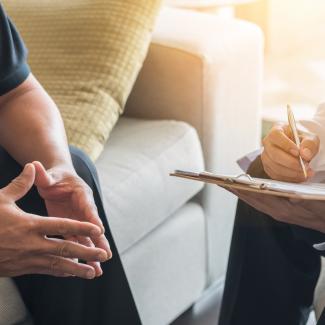Since October is Breast Cancer Awareness Month, at Marijuana Doctor we thought it would be helpful to share how medical marijuana may fit into a breast cancer patient's treatment plan.
The most frequently asked questions our doctors get on this topic include: How is medical marijuana used to treat breast cancer patients? What are the benefits? Can marijuana actually cure cancer? What is the best way to use marijuana to treat breast cancer? And are there any unwanted side effects?
It’s important to state upfront that, although there have been some promising lab studies, there is currently very little evidence to suggest that medical marijuana cures cancer. However, research does suggest that cannabis may someday be used to prevent, slow, or kill tumors. For now, medical marijuana is used in combination with traditional cancer treatments.
One example of a promising lab study on the use of cannabis in cancer treatment was just recently completed at the University of South Carolina. In their report, published in iScience, researchers claim that mice which were injected with tetrahydrocannabinol (THC) and a strong cancer-causing chemical did not develop cancer, while those who did not receive the THC along with the cancer-causing chemicaldid develop tumors. Co-author Prakash Nagarkatti said in a statement that his team was “really excited to see those results, which were so dramatic."
There are other examples of similar studies on both THC and CBD that have shown similar results. However, no one can say with surety that THC can prevent, treat, or cure cancer in humans.
So let’s look at how medical marijuana fits into a breast cancer treatment plan.
How Medical Marijuana Can Be Used By Breast Cancer Patients
The fact is, doctors are not recommending medical marijuana to breast cancer patients in order to treat tumors, but rather to treat a number of ancillary conditions that often come with the harsh protocols used to treat cancer such as chemotherapy and radiation.
While medical marijuana can’t replace these treatments, it is being widely used to safely and effectively manage the side effects of those treatments. Some examples of the side effects from which our patients are finding some measure of relief include anxiety and depression, fatigue and sleeplessness, nausea, and pain.
In May 2020,, Breastcancer.org announced the results of a study on the use of medical marijuana by breast cancer patients. According to their surveys, more than 42 percent of breast cancer patients have used medical marijuana. And the majority of those patients who used marijuana as part of their treatment plan reported that medical marijuana was indeed effective at reducing pain, nausea, and anxiety.
According to the data:
-
78% of those who used medical marijuana in their treatment protocol reported using medical marijuana to treat pain
-
70% reported using marijuana to treat insomnia
-
57% reported using marijuana to treat anxiety
It’s important to state at this point that medical marijuana is not a singular treatment. There are a number of different strains of cannabis and several delivery methods, each with its own set of benefits and drawbacks.
For example, while some cannabis strains and their extracts are high in THC, the intoxicating compound found in marijuana, others are low in THC but high in CBD, a non-intoxicating cannabinoid.
Learn more: 4 Main Differences differences between THC and CBD
Each strain of cannabis produces a unique set of active compounds known as terpenes. And each terpene also comes with its own effects. This combination of effects produced by the cannabinoids and terpenes found in a particular strain is known as the entourage effect.
Learn more: What is the Entourage Effect?
Learn more: Role of Terpenes in Medical Marijuana
While some strains can increase energy and wakefulness, others can induce relaxation and act as a sedative. If a patient is feeling fatigued during the day, a strain that acts as a sedative would have unwanted effects. However, that same strain might be helpful for a patient who is having trouble sleeping. Furthermore, some cannabis strains are known to reduce appetite while others will increase appetite. For this reason, it’s important to discuss your needs with one of our certified medical marijuana doctors before rushing off to a medical marijuana dispensary.
Another factor that will determine the ideal treatment protocol for an individual patient is the delivery method. Some medical marijuana products such as cannabis-infused baked goods can take up to an hour or more to take effect, while others such as smoking and vaping can produce immediate results.
For patients suffering from sudden onset symptoms such as pain or nausea, a product with a fast onset time is ideal, while patients suffering from conditions such as insomnia might benefit more from a product with longer-lasting effects such as edibles.
We’re not going into too much more detail on cannabis strains and delivery methods in this article because it’s important that cancer patients not make guesses — even educated ones — but rather confer with one of our state-certified medical marijuana doctors.
Desired Effects vs. Unwanted Side Effects
Oftentimes we hear from our patients that they are under the impression — either as a result of articles that they’ve read or via word-of-mouth — that marijuana does not produce any “side effects.” For most patients, marijuana will not produce any serious or life-threatening side effects, but that’s not the whole story. One patient’s desired effects might be unwanted effects for another.
Similar to the above example, a patient suffering from depression might benefit from a cannabis strain with some measure of THC for its uplifting effects. On the other hand, patients who want to avoid feeling “high” are better served using a strain that is high in CBD and low in, or devoid of, THC. Some other undesirable side effects of THC can include reduced motor skills, loss of short term memory, red eyes, and dry mouth.
Furthermore, a number of factors should be taken into account when considering which delivery method to choose from. For example, smoking and vaping have been known to contribute to asthma and bronchitis in some patients. And using edibles that are high in sugar is not recommended for patients with diabetes.
Another major consideration is the dosage. Cannabis is what is known as a bi-phasic drug. This means that different dosage levels, it can produce different effects. Another common example of a biphasic drug is alcohol. When used in moderation, alcohol can be uplifting but when consumed in high quantities it can severely hamper motor skills and cause nausea, vomiting, and even unconsciousness.
Reducing Breast Cancer Treatment Side Effects
There are four main symptoms for which our breast cancer patients are using medical marijuana as part of their treatment. These are:
-
Anxiety and depression
-
Acute and chronic pain
-
Nausea and vomiting
-
Insomnia
Anxiety and Depression
Being diagnosed with breast cancer is bound to cause some measure of anxiety or depression in even the strongest patients. CBD is commonly used to treat anxiety while THC is often effective at treating depression. Many patients have some level of both anxiety and depression and can benefit from a strain that produces a mixture of both cannabinoids.
Acute and Chronic Pain
Pain is a common symptom of advanced cancer cases. It is also a common side effect of cancer treatments including injections and surgery. Traditionally, opioids are prescribed to treat acute and chronic pain that often comes with breast cancer treatment. However, opioids are highly addictive and can cause severe side effects and even death. Medical marijuana on the other hand provides safe and effective relief from pain for many breast cancer patients.
Nausea and Vomiting
Breast cancer patients undergoing treatments such as chemotherapy and radiation often suffer from severe nausea and vomiting after undergoing treatment. For many of these patients, cannabis provides highly effective relief. Marijuana’s ability to alleviate nausea and vomiting are strongly supported by research. And, as we mentioned earlier, delivery methods such as smoking and vaping can often provide immediate relief.
Insomnia
Anxiety, pain, and nausea can often interfere with getting a good night’s sleep. Cannabis can be effective at reducing all three of these common side effects of cancer treatments and also act as a sedative.
A final word on breast cancer and medical marijuana
To recap, medical marijuana is not a singular treatment. There are different strains and delivery methods, each of which might be well suited to one patient but not every patient. Furthermore, the effects of cannabis are dosage-dependent.
Breast cancer patients are strongly advised to seek the counsel of a medical professional who is trained in the use of medical marijuana in the treatment of breast cancer.
The state-certified doctors at all of our Marijuana Doctor medical offices work individually with patients to discuss the potential options for delivery methods for their condition and lifestyle.
Visit us online at MarijuanaDoctor.com to schedule a free consultation, or call (844) 442-0362 to talk with one of our professional, experienced, and licensed staff members.
Learn more about Breast Cancer Awareness Month.
























